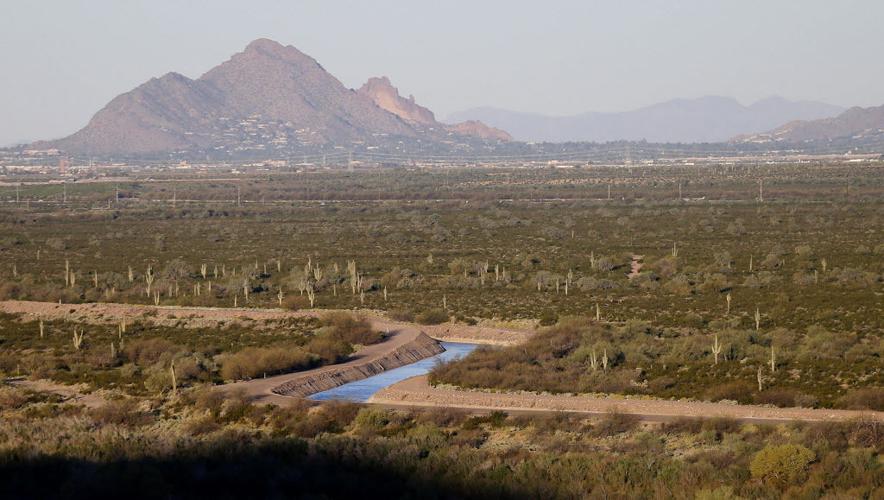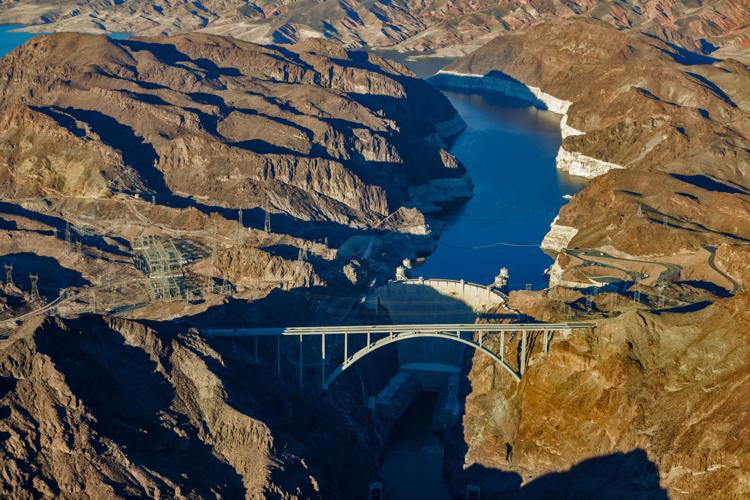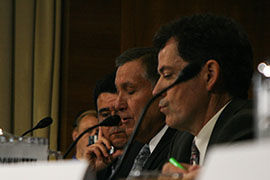A proposed 2015 sale of Arizona water to California that never happened is now a flash point in a controversy pitting Arizona’s top water agency against the Central Arizona Project.
A newly disclosed memo from that year, written by a CAP attorney, characterized the proposal as a sale of some of Arizona’s Colorado River water to the giant, six-county Metropolitan Water District in Southern California. Such a sale would be controversial in Arizona, given the longstanding adversarial relationship over water between the two states.
The deal would have allowed the “Met” to store or use 60,000 acre-feet of Arizona’s Colorado River water for about $17 million in payments to CAP and a promise to return that water later to CAP, which serves drinking water to Tucson and Phoenix.
CAP officials said then and now that the arrangement would only have been to store 60,000 acre-feet of Arizona’s share of river water with the Southern California water district — not to sell it. But Arizona Department of Water Resources officials have now seized on the 2015 memo to say this was a “rogue action” by CAP that shows that agency’s authority must be curbed.
Under the proposed deal, the Met would have been required to return the water to Arizona when Lake Mead dropped below 1,050 feet, far lower than it is now. That low a lake level would trigger a serious shortage for the CAP, a $4 billion Arizona water project. But the deal was killed after the Arizona Department of Water Resources objected to it as illegal and bad policy.
State water resources officials say the May 2015 memo to four CAP officials from private CAP attorney Stuart Somach is a smoking gun.
The Sacramento-based lawyer wrote that “I am not at all sure that one ever avoids the obvious reality that Arizona is, to a greater or lesser degree, selling water to California.”
Overall, Somach’s memo was favorable to the idea of the water transaction on other grounds. But its release has been used by the Arizona Department of Water Resources as ammunition in its effort to get legislation passed curbing CAP’s legal authority.
These proposed measures have been debated by a Colorado River working group, appointed by Gov. Doug Ducey, that’s been meeting privately through the summer.
One proposal under discussion would forbid CAP from hiring a Washington, D.C., lobbyist. Another would require periodic state audits of CAP’s performance.
CAP officials, however, say that far from taking a rogue action, they were working with the state water department back in 2015 to evaluate the California plan in a “collaborative and deliberative manner.”
The very fact that the CAP bowed to the state agency’s objections shows it was hardly acting as a rogue, project officials say.
Somach “was making a point about the public perception of the proposal,” not coming to a legal conclusion with regard to a “sale,” CAP spokeswoman Crystal Thompson said in an email to the Star.
“The first part of the transaction involved Arizona water being stored in California, with California compensating Arizona for the costs involved. By itself, that would look like a sale,” Thompson said. “However, viewed as a whole, the proposal involved the second part, occurring later in time, which would have required California to return the same amount of water to Arizona (during a shortage). That element makes it clearly not a sale.”
Private water attorney Kathleen Ferris, who was director of the state Department of Water Resources in the mid-1980s, countered that Somach “says the obvious reality, not the perception, is that Arizona is by a greater or lesser degree selling water to California. CAP can claim anything they want but the facts are now what they are.”
Tom Buschatzke, the Department of Water Resources’ current director, said, “If their own attorney says it’s a sale, how is it not a sale? It would boggle my mind that anyone who read that would interpret that to mean it is anything other than a sale.”
Somach’s office referred a reporter’s request to speak to the attorney on the 2015 memo to CAP spokeswoman Thompson.
SHORTAGE PRESSURES
The CAP-Met deal was conceived at a time when short-term conditions on Lake Mead were more precarious than now. This month, the U.S. Bureau of Reclamation said that after an unusually snowy winter in the northern Rockies, the Colorado River and its reservoirs, lakes Mead and Powell, contain enough water that there is no chance of a shortage in 2018. There is a 31 percent chance of a shortage in 2019, the bureau said.
At the end of April 2015, by contrast, the previous winter’s snowpack was low enough that the bureau was predicting a much bigger chance of imminent shortages.
The Metropolitan Water District was facing its own water pressures then, as the California drought was peaking. The Met had received only 5 percent of its normal supplies from the California State Water Project’s reservoirs in 2014.
The CAP laid out the early terms of the California deal in an April 20, 2015, memo, marked “Confidential and Privileged.” It’s one of a package of memos on the deal that CAP gave the governor’s river working group this summer, including Somach’s. Until then, state and CAP officials had withheld Somach’s memo under a confidentiality agreement. Buschatzke said his agency decided to release it this month because CAP had given it to other parties.
The money paid to Arizona in this deal would have gone partly to CAP, some to offset higher water costs its customers — including Tucson — would pay for river water if less was available in a shortage. Some would have been spent to build wells and other infrastructure to retrieve water that’s been stored underground across Arizona to be used during a severe shortage. The rest would have gone to the Arizona Water Banking Authority, which buys and recharges otherwise unused Colorado River water into the aquifer.
Besides the money paid to Arizona, the deal’s “pros” were that California would share a shortage with Arizona by repaying CAP the “stored” water during a shortage, CAP’s memo said.
California has been considered free of worries about shortages because the 1968 law that authorized CAP’s construction gave California first priority for river water during shortages and Arizona last priority.
Plus, the CAP would be supporting California during its drought, which theoretically would improve relations between the two fractious states.
But the memo acknowledged a key “con”: that this transaction would risk the “optics” of “selling” Arizona’s unused water to the Metropolitan Water District, an agency long feared and distrusted in some circles in this state.
Plus, the memo said the deal would not address the Lower Colorado River Basin’s structural deficit between water use and supply that many experts consider the root cause of Lake Mead’s problems.
In several memos, CAP saw this plan as a demonstration project, implying that it could be done in future years if the first year proved successful.
Somach’s May 12 memo laid out several uncertainties about the deal, including “who, in fact, benefits from this transaction.”
But he did find merit in the idea that it would have provided “real wet water” to CAP during a shortage.
“That benefit has a great deal of value,” he wrote.
On July 7, 2015, CAP official Chuck Cullom wrote other CAP officials an email saying water director Buschatzke and other state officials not only supported the concepts behind the deal, they were “in lockstep” on key issues.
OFFICIALS’ MEMORIES CLASH
In an interview this month, however, Buschatzke denied that his agency had ever endorsed the deal. That’s one of several differences the two agencies’ officials have in their recollections of it.
His agency knew nothing of this agreement until meeting with CAP and Met officials in mid-June, “when we were invited to talk about drought planning,” Buschatzke said.
After evaluating the proposal, the state water department’s attorneys concluded it wasn’t legal and that the only agency in Arizona authorized to do any form of interstate water banking — as this deal was proposed — is the Arizona Water Banking Authority.
Even then, the only forms of interstate banking authorized for the authority would be in Arizona, not out of state, Ferris said.
The state got most of the agreement’s key details after it signed a confidentiality agreement on them on July 7, 2015, Buschatzke said. “Two weeks later, we did our analysis and told CAP that this deal was not going to work,” he said.
On Aug. 7, 2015, CAP General Manager Ted Cooke wrote to Met officials that after talking with Buschatzke and meeting in executive session with CAP’s governing board, it was clear this deal couldn’t proceed.
Another reason the department opposed the deal is that the river water California would get could have been used instead to prop up Lake Mead to help avert a shortage, Buschatzke said.
“We had a 75,000 acre-feet buffer at the lake, and CAP was going to take 60,000 of this buffer and ship it out to Met. This would have put Arizona at risk ... of going into shortage,” he said.
CAP DEFENDS DEAL
In her memo to the Star this month, CAP spokeswoman Thompson said fears the deal could have caused a shortage were unfounded.
The water that would have been stored with the Met had been planned to be delivered — and was ultimately delivered — to the Arizona water bank’s underground recharge basins that year, Thompson said.
“The result in either case was the same — there would have been no change to Lake Mead” if the deal had gone through, she said.
“CAP is saddened and disappointed that ADWR would continue to make false statements about discussions from two years ago, particularly since ADWR was party to the discussions and no agreement or action resulted,” Thompson wrote.
“This political rhetoric is a distraction that weakens and divides Arizona water users at the very time Arizona water managers need to work cooperatively to address the very real water issues facing our state.”
But her statement regarding Lake Mead is contradicted by two memos contained in the package of documents CAP gave to the governor’s Colorado River task force. The memos, dated July 7 and July 8 of 2015 and again marked confidential, said the water the Met would store was water that CAP planned to use or store in Mead.
CAP also disagrees with the state on whether the deal was illegal.
Somach’s May 2015 memo and Thompson’s comments to the Star this month said CAP was authorized by federal interstate storage regulations to store the water in California.
Plus, “the transaction was entirely within CAP’s authorities under Arizona law,” Thompson said.
Thompson didn’t reply to requests from the Star for specifics on how the deal complied with Arizona law.








